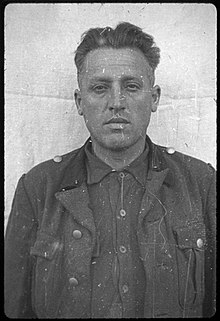Wilhelm Wagner (SS member)
Wilhelm Wagner (born November 28, 1904 in Augsburg , † May 29, 1946 in Landsberg am Lech ) was a German SS-Hauptscharführer and was deployed as a commando leader in the Mauthausen and Dachau concentration camps (both in the main camp and in several satellite camps ).
biography
Wagner, an electrical engineer by profession, was married and had two children. He joined the SS and the NSDAP in June 1933. From September 18, 1933, Wagner was a permanent member of the Dachau concentration camp team until he was transferred to Mauthausen concentration camp on August 4, 1938 , where he remained until November 30, 1939. From January 1940 until the late summer of 1943, Wagner worked in the prisoners' laundry in the Dachau concentration camp, where he served as director from the beginning of January 1942. 60 to 80 inmates were employed in the inmate laundry, who were responsible for cleaning the inmates' clothing and the clothing of the guards. From October 1943 to April 1944, Wagner headed a work detachment in the Germering subcamp in Dachau , which he initially brought daily from the Dachau concentration camp to work in the Germering subcamp; from January 1944 this work detail was permanently transferred to Germering. From April to August 1944 he was assigned to the Allach subcamp as a command officer and then until November 1944 as a camp leader in the Riederloh II subcamp . From November 24, 1944 to the end of April 1945, he was in charge of the Landsberg subcamp at the Penzing air base .
After the end of the war, Wagner was arrested and on November 15, 1945, in the main Dachau trial, which took place as part of the Dachau trials , charged with war crimes before an American military court. On December 13, 1945 Wagner and 35 other co-defendants were sentenced to death by hanging . A large number of severe mistreatment of prisoners by Wagner were taken into account as excesses in the verdict. Among other things, he kicked prisoners and hit them with a piece of wood; at least one inmate died as a result of the abuse. In addition, Wagner took part in the execution of two prisoners in the Allach subcamp on the orders of camp leader Josef Jarolin .
In a petition for clemency dated December 21, 1945, Wagner asked for his death penalty to be converted into a prison sentence . In the petition for clemency he stated:
“It is true that while I was working there I repeatedly beat prisoners, but only if they were guilty of any offense. I have never reported to punish them and I know they would have received much harsher punishments than my slaps. This saved the lives of many prisoners. "
He also offered to make himself available to the concentration camp doctor Claus Schilling , who was also sentenced to death, for his malaria experiments. This request for clemency, supported by his wife and mother, who has since divorced from him, was not granted. The sentence was carried out on May 29, 1946 in the Landsberg War Crimes Prison .
literature
- Case No. 000-50-2 (US vs. Martin Gottfried Weiss et al.) Tried 13 Dec. 45 , English; (pdf; 40.9 MB)
- Wolfgang Benz , Barbara Distel (ed.): The place of terror . History of the National Socialist Concentration Camps. Volume 2: Early camp, Dachau, Emsland camp. CH Beck, Munich 2005, ISBN 3-406-52962-3 .
Web links
Individual evidence
- ↑ Case No. 000-50-2 (US vs. Martin Gottfried Weiss et al.) Tried 13 Dec. 45, p. 31 f.
- ^ Benz, Distel: Der Ort des Terrors , Volume 2, Munich 2006, p. 471.
- ↑ Case No. 000-50-2 (US vs. Martin Gottfried Weiss et al.) Tried 13 Dec. 45, p. 146 f.
- ^ Holger Lessing: The first Dachau trial (1945/46). Nomos Verlagsgesellschaft, Baden-Baden 1993, ISBN 3-7890-2933-5 , p. 325.
- ↑ Quoted from: Manfred Deiler: Wilhelm Wagner - perpetrators in the SS labor camp in Landsberg . 2005
- ^ Manfred Deiler: Wilhelm Wagner - perpetrators in the SS labor camp in Landsberg . 2005
| personal data | |
|---|---|
| SURNAME | Wagner, Wilhelm |
| BRIEF DESCRIPTION | German SS-Hauptscharführer and commando leader in concentration camps |
| DATE OF BIRTH | November 28, 1904 |
| PLACE OF BIRTH | augsburg |
| DATE OF DEATH | May 29, 1946 |
| Place of death | Landsberg War Crimes Prison |

